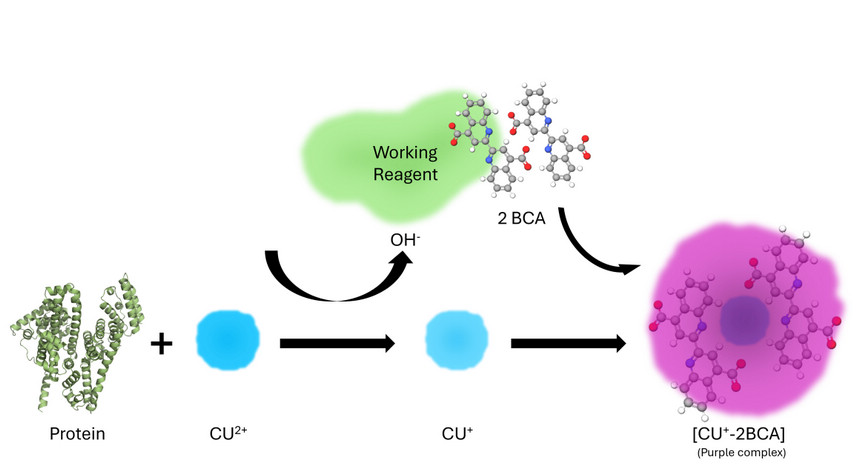| RealQuant BCA Protein Assay Kit | Package |
|---|---|
| RealQuant BCA reagent A | 500ml x 1 |
| RealQuant BCA reagent B | 11ml x 1 |
| Bovine serum albumin (BSA) standards | 0.5 mL x 10 |
| Quick Facts |
| Absorption spectrometer detection wavelength (nm):562 |
| The volume ratio of reagent A / reagent B:50 / 1 |
| Sample / Working solution volume (ratio):5~10 μL / 200 μL (1/20~40) |
| Reaction temperature and time:120 minutes at room temperature or 37°C for 30 minutes |
| Working range of protein concentration:20~2000 μg/mL |
Protocol:
- Preparation of the BCA working solution (WS):
- Use the following formula to determine the total volume of WS required:
2.0 mL of WS is required for each sample in cuvette method;
200 μl of WS is required for each sample in 96-well microplate method;
400 μl of WS is required for each sample in 0.5 mL thin-walled PCR tube; - Prepare WS by mixing 50 parts of Reagent A with 1 part of Reagent B.
For the above example, combine 50 mL of Reagent A with 1mL of Reagent B.
Note:When Reagent B is first added to Reagent A, turbidity is observed that quickly disappears upon mixing to yield a clear, green WS. Prepare sufficient volume of WS based on the number of samples to be assayed. Although the WS is stable for several days when stored in a closed container at room temperature, it is NOT recommended to store the WS overnight. - Cuvette(sample to WS ratio = 1:20)
- Pipette 0.1 mL of each standard and unknown sample replicate into an appropriately labeled cuvette.
- Add 2.0 mL of the WS to each cuvette and mix well.
- Cover and incubate tubes at selected temperature and time: 37°C for 30 minutes or RT for 2 hours (working range = 20–2000 μg/mL);60°C for 30 minutes (working range = 5–250 μg/mL).
- Cool all tubes to RT.
- With the spectrophotometer set to 562 nm, zero the instrument on a cuveĴe filled only with water, then measure the absorbance of all the samples within 10 minutes.
Note:Because the BCA assay does not reach a true end point, color development will continue even after cooling to RT. However, because the rate of color development is low at RT, no significant error will be introduced if the 562 nm absorbance measurements of all tubes are made within 10 minutes of each other.
Note:The detection is successful in the wavelength range of 540-590 nm. - Subtract the average 562 nm absorbance measurement of the Blank standard replicates from the 562nm absorbance measurement of all other individual standard and unknown sample replicates.
- Prepare a standard curve by plotting the average Blank-corrected 562 nm measurement for each BSA standard vs. its concentration in μg/mL. Use the standard curve to determine the protein concentration of each unknown sample.
- Microplate (sample to WR ratio = 1:8)
- Pipette 25 μL of each standard or unknown sample replicate into a microplate well (working range = 20–2000 μg/mL).
- Add 200 μL of the WS to each well and mix plate thoroughly on a plate shaker for 30 seconds.
- Cover plate and incubate at 37°C for 30 minutes or RT for 2 hours (working range = 20–2000 μg/mL);60°C for 30 minutes (working range = 5–250 μg/mL).
- Cool plate to RT. Measure the absorbance at or near 562 nm on a plate reader. Note:Wavelengths from 540–590 nm have been used successfully with this method.
- Subtract the average 562 nm absorbance measurement of the Blank standard replicates from the 562 nm measurements of all other individual standard and unknown sample replicates.
- Prepare a standard curve by plotting the average Blank–corrected 562 nm measurement for each BSA standard vs. its concentration in μg/mL. Use the standard curve to determine the protein concentration of each unknown sample.
Additional information:
- Please protect all solutions from light.。
- Increasing the incubation time or temperature increases the net 562 nm absorbance for each test and decreases both the minimum detection level of the reagent and the working range of the protocol. If prolonging the incubation time or increasing the temperature still CANNOT meet your detection needs at low protein concentration, you can adjust the ratio of agent A/agent B to 25/2, and adjust the ratio of sample to working solution to 1/10, incubate at room temperature for 15-30 minutes, in our experience, this adjustment can improve the detection sensitivity of the kit.
- . Using a forced-air incubator can introduce significant error in color development because of uneven heat transfer.

